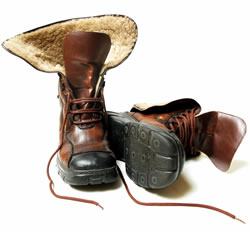Unfortunately, hiking boots that aren’t really well suited for actual use are a dime a dozen. If you’re an avid hiker, you likely already know what I’m talking about. Thin, plastic-y discount boots with almost zero waterproofing and comfort abound on outdoor store shelves. There’s nothing inherently wrong with bargain shopping when it comes to outdoor equipment – after all, many non-name-brand outdoor products like backpacks and tents do the job just as well as their more expensive counterparts. But when you consider the amount of time you’ll spend with your feet firmly planted in those boots, it makes sense that this is one area in which you won’t want to skimp. Here’s what you should be looking for when trying to find the right hiking boots for you.
Characteristics of High-Quality Boots
 Good hiking boots have several things in common with one another. First and foremost is material. While composite materials are becoming increasingly popular among hiking boot manufacturers, good old-fashioned leather is hard to top when it comes to material. It’s naturally sturdy, stain-resistant, and waterproof. Look for boots that have a majority of their material made out of leather. Second is the attachment of the tongue. If it’s completely loose from the rest of the boot all the way down to where it attaches to the toe, odds are that boot will be far from waterproof. People who hike in areas with lots of creeks or muddy soil will quickly be trudging around with cold, wet feet in these kinds of boots. Look for ones that have an attached tongue to at least the ankle area.
Good hiking boots have several things in common with one another. First and foremost is material. While composite materials are becoming increasingly popular among hiking boot manufacturers, good old-fashioned leather is hard to top when it comes to material. It’s naturally sturdy, stain-resistant, and waterproof. Look for boots that have a majority of their material made out of leather. Second is the attachment of the tongue. If it’s completely loose from the rest of the boot all the way down to where it attaches to the toe, odds are that boot will be far from waterproof. People who hike in areas with lots of creeks or muddy soil will quickly be trudging around with cold, wet feet in these kinds of boots. Look for ones that have an attached tongue to at least the ankle area.
Following closely behind these two factors in hiking boot selection is the boot’s sole. For most types of terrain, a boot’s sole should have relatively soft, deep tread. Soles of this nature allow for cushioned steps and increased stability on soft, unsteady ground. If the tread seems thinner or harder than normal, then it’s likely that you’re looking at a work boot as opposed to a hiking boot.
Making Sure The Shoe Fits
When you were a kid, mom probably recommended that your shoes be a little big and loose when new. After all, tearing up shoes monthly with your growing feet probably didn’t exactly fit the family budget. When looking for hiking boots, however, you should throw this advice out completely. When you try the boots on for the first time, lace them up as tightly as possible, and walk around in them as much as you can. Because they’re not broken in yet, they probably won’t be very comfortable. The key thing to feel for is slippage. If you feel your foot slip inside the boot at all, then they’re either not laced tight enough or too big.
Aside from personal preference in appearance, all good hiking boots are actually pretty similar in form and function. Getting the right pair might equate to a one-time painful hit to your wallet, but the dividends paid in terms of comfort and effectiveness are well worth that initial cost. As experienced outdoor lovers know, happy hiking starts with the foot!


For me Hiking boots are heavy, durable for those activities but heavy. I usually use rubber shoes, do you think that I should go for hiking boots instead of rubber shoes when hiking/wilderness activities?